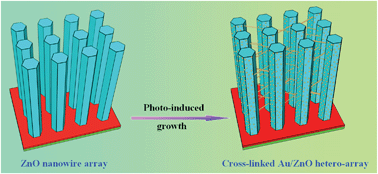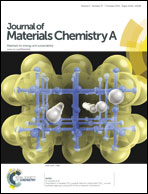Photo-directed growth of Au nanowires on ZnO arrays for enhancing photoelectrochemical performances†
Abstract
Herein, we demonstrate that ZnO nanowire arrays could be rationally connected with each other by thin Au nanowires to construct a novel cross-linked hetero-structure by a simple photo-directed growth strategy. Moreover, a possible formation mechanism of this Au/ZnO hierarchical nanostructure has been proposed. In the case of light irradiation, the rapid electron enrichment on the top (002) facets of ZnO nanowires will result in a high concentration of holes on the side facets, which could generate a positive electric field. As a result of the electronegativity, [Au(OH)xCl4−x]− (where x = 0–4) anions could be pulled in by this electric field and reduced on the side facets of ZnO nanowires, and the Au nanowires could be gradually formed through an exact opposite point growth route. Furthermore, the photoelectrochemical performance studies clearly reveal that these novel cross-linked hetero-arrays exhibit much higher visible light photocurrent density than both pure ZnO nanowire arrays and traditional Au nanoparticle/ZnO nanowire heterostructures, which may be primarily ascribed to the efficient electron transfer from Au nanostructures to ZnO nanowires.


 Please wait while we load your content...
Please wait while we load your content...